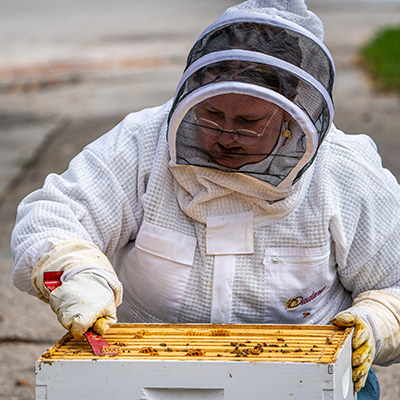The Zoo is filled with fascinating, hard-to-miss animal habitats: the bear exhibits with their rocky walkways; Lake Evinrude with its lush banks; and Otter Passage with its slippery slopes. But one animal home is easily overlooked. On the south side of Lake Evinrude, inside a white, wooden box, is a beehive and a colony of honey bees. The hive is maintained by the beekeeping committee, a group comprised of Milwaukee County Zoo and Zoological Society staff.
This white box, known as a Langstroth hive, is unassuming at first glance, but there’s much more than meets the eye. A peek inside the hive would reveal a row of vertical frames covered in hexagonal honeycomb, golden honey and more than 20,000 bees! Bees create honey by collecting nectar from flowers, chewing it up to change its chemical composition, spreading it over honeycomb, batting their wings to dry it out and finally capping the honeycomb with beeswax to keep it fresh. Bees eat honey, and the honey they produce sustains the colony throughout winter.

“Honey bees are incredibly sophisticated,” says Auriana Donaldson, conservation programs coordinator and member of the beekeeping committee. “They do most of the work; our job is just to support them.” The beekeeping committee maintains the health of the hive throughout the year by checking it for mites and other disturbances, monitoring the queen and her eggs, and making sure its inhabitants have enough honey to last the winter. If the hive has a sufficient amount of honey, the committee will harvest some of it. Last year, they harvested 20 pounds of honey, which was fed to the Zoo’s bears!
Since the mid-90s, honey bee populations throughout the United States have suffered dire declines due to loss of habitat, climate change, the use of pesticides and reduced genetic diversity. Pollinators like honey bees are responsible for one of every three bites of food we take, and beekeeping is one of the many ways the Milwaukee County Zoo and Zoological Society take an active role in pollinator conservation. Beekeeping might not be a possibility for everybody, but everybody can help honey bees in their own way by purchasing local honey, planting pollinator-friendly plants or simply letting bees be if they see them in nature.

